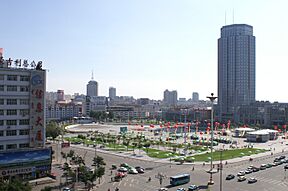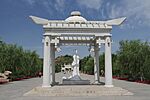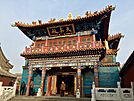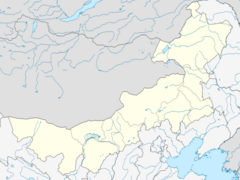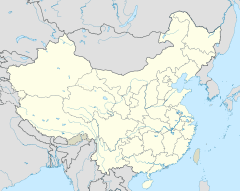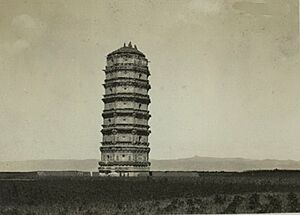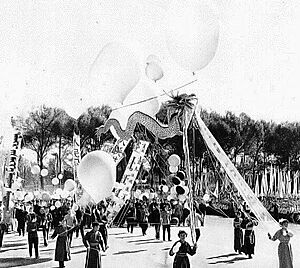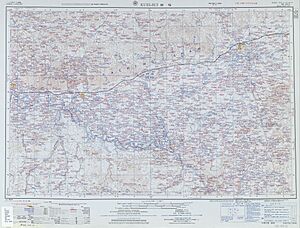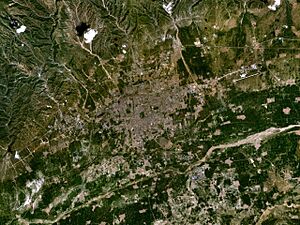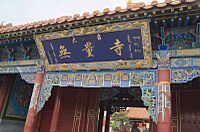Hohhot facts for kids
Quick facts for kids
Hohhot
呼和浩特 · ᠬᠥᠬᠡᠬᠣᠲᠠ
Huhehot, Kweisui, Kuei-sui
|
|
|---|---|
|
Prefecture-level city
|
|
|
Skyline with Hohhot Central Square
Statue of Altan Khan
Five Pagoda Temple
Zhaojun Tomb
Dazhao Temple
Monument of Genghis Khan
|
|

Location of Hohhot City jurisdiction in Inner Mongolia
|
|
| Country | |
| Region | Inner Mongolia |
| County-level divisions | 10 |
| Township divisions | 116 |
| Established | 1580 |
| Municipal seat | Xincheng District |
| Government | |
| • Type | Prefecture-level city |
| • Body | Hohhot Municipal People's Congress |
| Area | |
| • Prefecture-level city | 17,186.1 km2 (6,635.6 sq mi) |
| • Urban
|
2,065.1 km2 (797.3 sq mi) |
| • Metro | 4,830.1 km2 (1,864.9 sq mi) |
| Elevation | 1,065 m (3,494 ft) |
| Population
(2020 census)
|
|
| • Prefecture-level city | 3,446,100 |
| • Density | 200.517/km2 (519.336/sq mi) |
| • Urban | 2,681,758 |
| • Urban density | 1,298.61/km2 (3,363.38/sq mi) |
| • Metro | 2,944,889 |
| • Metro density | 609.695/km2 (1,579.103/sq mi) |
| • Major ethnic groups | |
| GDP | |
| • Prefecture-level city | CN¥ 309.1 billion US$ 49.6 billion |
| • Per capita | CN¥ 101,492 US$ 16,295 |
| Time zone | UTC+08:00 (China Standard) |
| Postal code |
010000
|
| Area code(s) | 471 |
| ISO 3166 code | CN-NM-01 |
| License plate prefixes | 蒙A |
| Local Dialect | Jin: Zhangjiakou-Hohhot dialect; Southern Mongolian |
| Administrative division code | 150100 |
| Hohhot | |||||||||||||||||||||||||||||
|---|---|---|---|---|---|---|---|---|---|---|---|---|---|---|---|---|---|---|---|---|---|---|---|---|---|---|---|---|---|

Hohhot as written in Mongolian
|
|||||||||||||||||||||||||||||

The Chinese name of Hohhot: Hūhéhàotè
|
|||||||||||||||||||||||||||||
| Chinese name | |||||||||||||||||||||||||||||
| Chinese | 呼和浩特 | ||||||||||||||||||||||||||||
| Hanyu Pinyin | Hūhéhàotè | ||||||||||||||||||||||||||||
| Literal meaning | "Blue City" (in Mongolian) | ||||||||||||||||||||||||||||
|
|||||||||||||||||||||||||||||
| Abbreviation | |||||||||||||||||||||||||||||
| Chinese | 呼市 | ||||||||||||||||||||||||||||
| Hanyu Pinyin | Hūshì | ||||||||||||||||||||||||||||
| Literal meaning | Ho[hhot] City | ||||||||||||||||||||||||||||
|
|||||||||||||||||||||||||||||
| Kweisui | |||||||||||||||||||||||||||||
| Traditional Chinese | 歸綏 | ||||||||||||||||||||||||||||
| Simplified Chinese | 归绥 | ||||||||||||||||||||||||||||
| Hanyu Pinyin | |||||||||||||||||||||||||||||
|
|||||||||||||||||||||||||||||
| Mongolian name | |||||||||||||||||||||||||||||
| Mongolian Cyrillic | Хөх хот | ||||||||||||||||||||||||||||
| Mongolian script | ᠬᠥᠬᠡᠬᠣᠲᠠ | ||||||||||||||||||||||||||||
|
|||||||||||||||||||||||||||||
| Russian name | |||||||||||||||||||||||||||||
| Russian | Хух-Хото | ||||||||||||||||||||||||||||
| Romanization | Hooh-Hoto | ||||||||||||||||||||||||||||
Hohhot is a big city in the north of China. It is the capital of Inner Mongolia, a special region in China. Hohhot is a very important place for the region's government, economy, and culture. In 2020, about 3.4 million people lived there.
The name Hohhot means "Blue City" in the Mongolian language. Blue is a very important color in Mongol culture. It stands for the sky, forever, and being pure. Sometimes, people mistakenly call it the "Green City." Hohhot is also home to Inner Mongolia University, which is the biggest university in the region.
Contents
History of Hohhot
How Hohhot Began
Long ago, this area was part of a Chinese region called Yunzhong Commandery. It was located between the Great Wall and the Yin Mountains. This area is now part of modern Hohhot.
The Yunzhong Commandery was created after a successful fight against some local groups. Later, it became a border area between the Han Chinese and the Xiongnu people. The Xiongnu often attacked this region.
However, during the time of Emperor Wu of Han, Yunzhong became a key place for military actions. In 127 BC, a general named Wei Qing led a large army from Yunzhong. They conquered important areas like Hetao and Ordos.
By 2 AD, the area had many towns and over 173,000 people. But later, its population dropped a lot. This happened because people left to escape attacks from northern groups.
Hohhot in Ming and Qing Times
In 1557, a Mongol leader named Altan Khan started building the Da Zhao Temple here. He wanted to show the Ming Chinese government that he was in charge of the southern Mongol tribes. A town grew around this temple and was called the "Blue Town" (Kokegota).
The Ming government had stopped the Mongols from getting Chinese goods like iron and cotton. In 1570, Altan Khan made a deal with the Ming. The Ming then changed the town's name to Guihua in 1575. This name meant "Return to Civilization."
Guihua grew quickly. By the early 1630s, over 150,000 people lived there. Mongol princes encouraged Chinese merchants to settle in the city. Sometimes, Mongol armies attacked Guihua, like when Ligdan Khan destroyed it in 1631.
Later, the Manchus started the Qing dynasty. The Kangxi Emperor sent soldiers to control the area. This was because it was a center for studying Tibetan Buddhism. The Qing built a strong military town called Suiyuan near Guihua. This town helped them protect Inner Mongolia from Mongol attacks.
In 1913, the new Republic of China combined Guihua and Suiyuan. They named the new city Guisui. It became the capital of Suiyuan Province.
Hohhot in Modern Times
Connecting Guisui to railway lines helped its economy grow. It linked eastern China with western China's Xinjiang province. During the 1930s, Japan invaded China. They created a puppet state called Mengjiang. The Japanese renamed Guisui "Blue City" (Hohhot).
After Japan lost the war in 1945, the Republic of China changed the name back to Guisui. But after the Chinese Communist Revolution in 1949, the city was renamed Hohhot again.
In 1952, Hohhot became the main administrative center for the Inner Mongolia Autonomous Region. Since China started its economic reforms, Hohhot has grown a lot. New areas have been built, including government buildings and a stadium.
Hohhot is known for its history and temples. It is a popular place for tourists in Inner Mongolia. The city is also famous for its dairy companies, Mengniu and Yili. In 2005, it was even called the "Dairy Capital of China."
Geography and Climate
Where is Hohhot Located?
Hohhot is in the south-central part of Inner Mongolia. The Daqing Shan (Great Blue Mountains) are to its north. The Hetao Plateau is to its south.
Hohhot's Weather
Hohhot has a cold, dry climate. Winters are long, cold, and very dry. Summers are hot and a bit humid. Strong winds are common, especially in spring.
January is the coldest month, with an average temperature of -10.7°C (12.7°F). July is the hottest, averaging 23.2°C (73.8°F). The average temperature for the whole year is 7.6°C (45.7°F).
The city gets about 411 mm (16 inches) of rain each year. Most of this rain falls in July and August. Hohhot is a popular place for tourists in summer because of the nearby grasslands. However, due to desertification, sandstorms happen almost every year.
The city gets a lot of sunshine, about 2,680 hours per year. The lowest temperature ever recorded was -36.2°C (-33.2°F) in January 1930. The highest was 38.9°C (102.0°F) in July 2010.
City Layout and People
How Hohhot is Divided
Hohhot is a "prefecture-level city." This means it manages both its city areas and the countryside nearby. It has 4 city districts and 5 rural areas (counties and a banner). These are further divided into smaller towns and neighborhoods.
| Map | |||||||
|---|---|---|---|---|---|---|---|
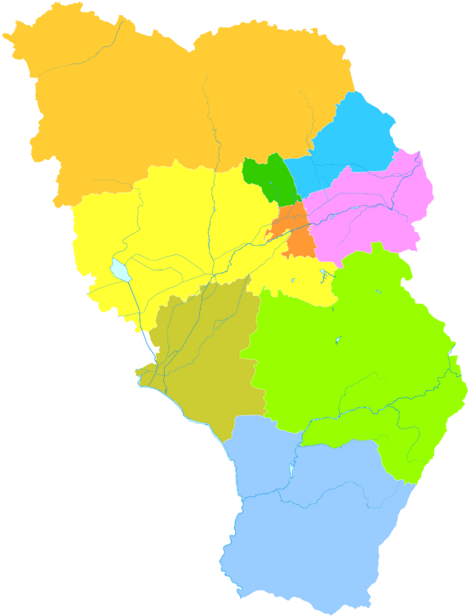
Xincheng
Huimin
Yuquan
Saihan
Tumed Left
Banner Togtoh
County Horinger
County Qingshuihe
County Wuchuan
County |
|||||||
| English Name | Mongolian | Simplified Chinese | Pinyin | Area | Population | Density | |
| City Proper | |||||||
| Huimin District (Hodong'arad District) |
ᠬᠣᠳᠣᠩ ᠠᠷᠠᠳ ᠤᠨ ᠲᠣᠭᠣᠷᠢᠭ (Qotoŋ Arad-un toɣoriɣ) |
回民区 | Huímín Qū | 194.4 | 394,555 | 2,030 | |
| Xincheng District (Xinhot District) |
ᠰᠢᠨᠡ ᠬᠣᠲᠠ ᠲᠣᠭᠣᠷᠢᠭ (Sin-e Qota toɣoriɣ) |
新城区 | Xīnchéng Qū | 660.6 | 567,255 | 859 | |
| Yuquan District | ᠢᠤᠢ ᠴᠢᠤᠸᠠᠨ ᠲᠣᠭᠣᠷᠢᠭ (Iui čiuvan toɣoriɣ) |
玉泉区 | Yùquán Qū | 207.2 | 383,365 | 1,850 | |
| Saihan District | ᠰᠠᠶᠢᠬᠠᠨ ᠲᠣᠭᠣᠷᠢᠭ (Sayiqan toɣoriɣ) |
赛罕区 | Sàihǎn Qū | 1,002.9 | 635,599 | 634 | |
| Rural | |||||||
| Togtoh County | ᠲᠣᠭᠲᠠᠬᠤ ᠰᠢᠶᠠᠨ (Toɣtaqu siyan) |
托克托县 | Tuōkètuō Xiàn | 1,407.8 | 200,840 | 143 | |
| Wuchuan County | ᠦᠴᠤᠸᠠᠨ ᠰᠢᠶᠠᠨ (Üčuvan siyan) |
武川县 | Wǔchuān Xiàn | 4,682.3 | 108,726 | 23 | |
| Horinger County | ᠬᠣᠷᠢᠨ ᠭᠡᠷ ᠰᠢᠶᠠᠨ (Qorin Ger siyan) |
和林格尔县 | Hélíngé'ěr Xiàn | 3,447.8 | 169,856 | 49 | |
| Qingshuihe County | ᠴᠢᠩ ᠱᠦᠢ ᠾᠧ ᠰᠢᠶᠠᠨ (Čiŋ šüi hė siyan) |
清水河县 | Qīngshuǐhé Xiàn | 2,859 | 93,887 | 33 | |
| Tumed Left Banner (Tumed Jun Banner) |
ᠲᠦᠮᠡᠳ ᠵᠡᠭᠦᠨ ᠬᠣᠰᠢᠭᠤ (Tümed Jegün qosiɣu) |
土默特左旗 | Tǔmòtè Zuǒ Qí | 2,765 | 312,532 | 113 | |
Who Lives in Hohhot?
| Historical population | ||
|---|---|---|
| Year | Pop. | ±% |
| 1953 | 792,600 | — |
| 1964 | 1,118,600 | +41.1% |
| 1982 | 1,645,200 | +47.1% |
| 1990 | 1,911,600 | +16.2% |
| 2000 | 2,437,900 | +27.5% |
| 2010 | 2,866,600 | +17.6% |
| Population size may be affected by changes on administrative divisions. | ||
Hohhot's population has grown quickly since the 1990s. In 2010, about 2.8 million people lived there. This was 428,717 more than in 2000.
Most people in Hohhot are Han Chinese. They make up about 87% of the population. Many Han people in Hohhot have ancestors from nearby provinces like Shanxi. Most Mongols in the city speak Chinese. Only a small number of Mongols in Hohhot speak the Mongolian language.
Here are the main ethnic groups in Hohhot, based on the 2000 census:
| Ethnicity | Population | Percentage |
|---|---|---|
| Han Chinese | 2,115,888 | 88.42% |
| Mongol | 204,846 | 8.56% |
| Hui | 38,417 | 1.61% |
| Manchu | 26,439 | 1.10% |
| Daur | 2,663 | 0.11% |
| Korean | 1,246 | 0.05% |
| Miao | 443 | 0.02% |
Hohhot's Economy and Culture
What is Hohhot's Economy Like?
Hohhot is a major industrial city in Inner Mongolia. It is one of the top three economies in the region, along with Baotou and Ordos. In 2012, its economy was worth about 247.56 billion Chinese Yuan.
The city is also a big shopping center. In 2012, people spent about 102.2 billion Yuan on goods. Hohhot is a key city in China's plan to develop its western regions. Many famous companies are based here. These include China's largest dairy producers, Inner Mongolia Yili Industrial Group and China Mengniu Dairy Co.
The city's business areas have grown a lot since the 1990s. New office buildings and shopping centers have been built.
Hohhot's Culture and Traditions
Hohhot has a mix of cultures. You can see many ethnic minority influences in the city. For example, Tongdao Road has buildings with Islamic and Mongol designs. The government has been adding more Mongol-themed buildings around the city.
All street signs and public transport announcements are in both Chinese and Mongolian.
Local Language
Older residents of Hohhot often speak the Hohhot dialect. This is a type of Jin Chinese, similar to what is spoken in Shanxi province. It can be hard for people who speak other Chinese dialects to understand. Newer residents usually speak Mandarin with a Hohhot accent.
Food in Hohhot
The local food in Hohhot focuses on Mongol dishes and dairy products. The city is famous for its dairy companies, Yili and Mengniu. A traditional Mongol drink called suutei tsai (milk tea) is a common breakfast choice.
Hohhot also has a rich tradition of making hot pot and shaomai. Shaomai is a type of Chinese dumpling often served as dim sum.
Getting Around Hohhot
Hohhot's Airport
Hohhot has the Hohhot Baita International Airport. It is about 14.3 km (9 miles) east of the city center. You can fly directly to major Chinese cities like Beijing and Shanghai. There are also flights to Taichung, Hong Kong, and Ulaanbaatar, Mongolia.
Train Travel
Hohhot is on the Jingbao Railway, which goes from Beijing to Baotou. The city has two train stations: Hohhot railway station and Hohhot East railway station. The railway started in 1921.
Trains connect Hohhot to Beijing and other cities in northern China. You can also take trains to most major cities in Inner Mongolia. There are even trains to Ulaanbaatar, Mongolia.
High-speed rail has improved travel times. In 2015, a fast train route opened between Baotou and Hohhot. It cut travel time between these two big cities to just 50 minutes. Another high-speed line linking Hohhot to Zhangjiakou opened in 2017.
Roads and Buses
A major expressway built in 1997 connects Hohhot with Baotou. This road has been extended to Beijing. Hohhot is also on China National Highway 110, which goes from Yinchuan to Beijing.
Long-distance buses connect Hohhot to nearby towns and other cities in Inner Mongolia. Inside the city, you can use buses or taxis. Bus fare is usually 1 yuan. Taxi fares start at 8 yuan.
Metro System
The Hohhot Metro system is now running. Line 1 opened on December 29, 2019.
Education in Hohhot
Hohhot has several universities and high schools.
- Inner Mongolia University is the only "211 Project" university in Inner Mongolia. This means it is one of China's top universities.
- Inner Mongolia University of Finance and Economics
- Inner Mongolia University of Agriculture
- Inner Mongolia Normal University
- Inner Mongolia University of Technology
- Inner Mongolia College of Medicine
- Honder College of Inner Mongolia Normal University
Some high schools in Hohhot include:
- Hohhot No.2 Middle School
- Affiliated Middle School to Inner Mongolia Normal University
- Hohhot experimental middle school
- Hohhot No.1 Middle School
Sports in Hohhot
Hohhot has a professional soccer team called Nei Mongu Zhongyou F.C. They play in China League One. Their home stadium is the Hohhot City Stadium. The team moved to Hohhot in 2015.
Famous Places to Visit
Hohhot has many historical sites and temples. Over 50 Buddhist temples and towers were built here during the Ming and Qing dynasties.
- Zhaojun Tomb: This tomb is about nine kilometers south of the city. It is believed to be the tomb of Wang Zhaojun. She was a woman from the Han Empire who married a Xiongnu king.
- Baita Pagoda: This pagoda is in the eastern part of the city, near the airport. It was built during the Liao Dynasty. Hohhot's airport is named after it.
- Da Zhao Temple: Located in the old part of Guihua town, this is the oldest Buddhist lama monastery in the city. It was built during the Northern Yuan Dynasty.
- Temple of the Five Pagodas: This temple is in the eastern part of Guihua town. It was finished in the Qing Dynasty. Its architecture looks a lot like Indian temples. Its walls have over 1,500 figures of Buddha.
- Residence of Gurun Princess Kejing: This was the home of Gurun Princess Kejing of the Qing Dynasty. She married a Mongol prince.
- Residence of the General: This building was the home and office for the Suiyuan Generals during the Qing Dynasty.
- Great Mosque of Hohhot: This mosque is located outside the northern gate of Guihua town. It was built during the Qing Dynasty.
- Inner Mongolia Museum: Here you can see dinosaur fossils and old items from nomadic peoples. You can also learn about the culture of modern nomadic groups.
- Qingcheng Park: This park, formerly called People's Park, is in the city center.
Images for kids
See also
 In Spanish: Hohhot para niños
In Spanish: Hohhot para niños


